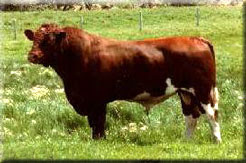For anybody who is not actively involved in the cattle business, breeds of cattle probably don't mean a lot to them. Of course, almost everyone is familiar with the "Angus" burger sold at McDonald's, but what the people don't know is the number of beef breeds they consume every year!
There is an interesting history to the beef breeds in North America. During the 1950's and 60's, only 3 breeds were heavily used- Aberdeen Angus, Shorthorn, and Hereford. While things may have seemed simple, a number of problems were bringing down the beef industry. Weaning weight were low, cattle were very small in size, and ranchers struggled to sell their bulls. Cattlemen realized that changes needed to be made to improve performance, production, and find more efficient cattle. They started with performance testing, then line breeding- breeding of animals that share common ancestors, and crossbreeding- crossing more than 1 breed together. Through crossbreeding, many found the hybrid vigor a success. However, there was also the idea to use new, different breeds all together.
 |
| A Shorthorn bull from 1969 raised by my grandparents, quite a bit smaller than today's cattle |
While the 3 "British" breeds being used were already in North America, a number of "exotic" breeds were waiting in Europe. Through a process of applications and permits, the import of the exotics from Europe began!
Here are just a few breeds and where they originated in
Simmental- Switzerland
Fleckvieh- Germany, Austria
Charolais-France
Maine-Anjou-France
Limousin- France
Gelbvieh- Germany
* There were many more breeds that were imported but aren't quite as popular today
The exotics, now called "continentals", were admired as they were growthier and more heavily muscled. They had great potential and cash value. While many traditionalists remained with their British breeds, many others took a chance for a new future. By adding the breeds most exciting sires to breeding programs, herds became enriched with performance and strong bloodlines. Many were greatly rewarded and stayed disciples of their chosen breed, while others stayed as long as the market was hot. Commercial cattlemen also saw it as an opportunity and changed their breeding programs forever. Until 1970, my family had always been Shorthorn breeders, but we then saw the potential in the Maine-Anjou breed. I guess you can say that the rest is history.
There are still dozens of beef breeds in production all over North American. The size and of cattle have been up and down over the years as well. While cattle were small in the 50's and 60's, the exotics brought quite a size change to cattle. They were tall and very extreme. In the present, cattle are at more moderate size that works for all cattlemen.
 |
| A full blood Maine-Anjou bull from the 1980's, very tall in structure |
 |
| A purebred Maine bull in the 1990's, slowly becoming smaller in size |
 |
| A present day purebred Maine bull, at a reasonable moderate size |

Great history Keltey! Very nice to see that you are open and respectful to all the beef breeds, something all cattleman should do.
ReplyDeleteHi. Do you know if your parents have any semen on any old bulls they bred?
ReplyDeleteHi there, sorry for not replying to this sooner. We do have semen on a number of Fullblood and purebred Maine-Anjou bulls. Please contact my aunt Deanna Wise at 403-935-4395 or send her an email at dedesphotos@hotmail.com if you would be interested in semen or live cattle. Thanks!
Delete